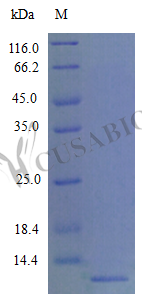The recombinant Mouse Ccl22,Abcd1,Scya22 was expressed with the amino acid range of 25-92. The theoretical molecular weight of the Ccl22,Abcd1,Scya22 protein is 7.8 kDa. The Ccl22,Abcd1,Scya22 protein was expressed in e.coli. The Ccl22,Abcd1,Scya22 coding gene included the Tag-Free, which simplifies the detection and purification processes of the recombinant Ccl22,Abcd1,Scya22 protein in following stages of expression and purification.
Mouse C-C motif chemokine 22 (Ccl22) is a small cytokine belonging to the CC chemokine family. It plays a key role in immune regulation and inflammation. Ccl22 is primarily secreted by dendritic cells, macrophages, and certain other immune cells. Its main function is to attract and modulate the activity of immune cells, particularly T lymphocytes, by binding to its receptor, CCR4. Research areas involving Ccl22 focus on understanding its role in immune responses, inflammation, and various diseases, including autoimmune disorders and cancer. Investigating the molecular mechanisms by which Ccl22 influences immune cell migration and function contributes to the development of potential therapeutic strategies targeting the chemokine system for immunomodulation and disease intervention.




